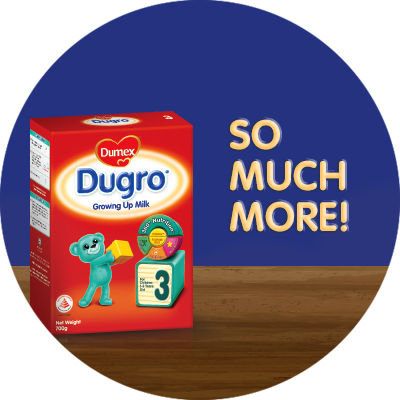Breastfeeding is the best for babies and a healthy diet / maternal nutrition is important when breastfeeding. A decision not to breastfeed can be difficult to reverse. Infant formula is suitable from birth when babies are not breastfed. It is recommended that all formula milks be used on the advice of a doctor, midwife, health visitor, public health nurse, dietitian, pharmacist, or other professional responsible for maternal and child care and the financial implications should be considered. All preparation and feeding instructions should be followed carefully as inappropriate preparation could lead to health hazards.
How Dumex Mamil Gold Helps with Nutrient Absorption?

Nutrition, undoubtedly, plays an important role in the growth and development of a child. As parents, it’s normal to be concerned about the nutritional values of the food our children consume. After all, we want them to grow up strong and healthy. Important nutrients like protein, carbohydrates, calcium, fibre and vitamin A are found in some of the foods that we are already familiar with. What matters most is the body’s ability to properly absorb the nutrients that enter the body, and a healthy gut plays a huge role in that regard1.
As a growing child that is in need of ample nutrition, these are some of the necessary nutrients and the respective foods that contain them2:
Protein
Protein is a macronutrient that plays a vital role in the growth and development of a child. Many bodily functions depend on protein to happen, such as the recovery and repair of tissues in the muscles and the breaking down of food into energy. A lack of protein could lead to varying health issues such as delayed wound healing and decreased immune response, which can be detrimental for a growing child.3
Protein is commonly found in meat, which is common among households. However, there’s also ample protein in other foods such as eggs, milk, nuts and beans.
Carbohydrates
Carbohydrates are the source of energy for all humans alike, regardless of age. As carbohydrates are ingested, they turn into glucose, which is the brain’s primary source of energy4. Most parents know that children tire themselves from running around, but what they didn’t realize is that children also spend a lot of time thinking, processing, and trying to make sense of everything they come across. This is why carbohydrates are so important for them.
There are simple and complex carbohydrates. Simple carbs are easily broken down by the body, commonly found in foods with refined sugars such as white bread, cane sugar, fruit juice, sweets & soft drinks. Complex carbs take longer for the body to break down, and are commonly found in whole grains, fresh fruits, whole grains bread/cereals and sweet potatoes.
Calcium
Calcium is the foundation of strong bones and teeth, which is why children need calcium the most. On average, 90% of girls achieve optimal bone mass by age 18, while 90% of boys achieve it by age 20 5. Having optimal bone mass means having your bones at its maximum strength and density, which is why investing in bone health since early age is important. Not just that, calcium keeps the nerves and muscles working and is important for blood clotting.
Foods that are rich in calcium include milk, cheeses, broccoli, seeds, almonds, soybeans and tofu.
Fibre
Fibre is the nutrient that’s responsible for one’s regular bowel movements. A diet that’s rich in fibre helps to promote regular bowel movement6 7. According to a study on the importance of dietary fibre in childhood6, it is recommended that your child’s dietary fibre intake should increase as they age. Fun fact 1: Prebiotics are types of dietary fiber that feeds the friendly bacteria in your gut. This helps the gut friendly bacteria to flourish in which produces a variety of beneficial compounds leading to a healthy digestive system.(8). Fun fact 2: most of the foods that are naturally rich in fibre are also good sources of nutrients and vitamins, such as fruits and vegetables.
Foods that are rich in fibre include lentils, seeds, nuts, fruits, vegetables and whole-grain cereals. Include a healthy amount of these in your child’s everyday meal whenever you can.
Vitamin A
Vitamin A plays a critical role in the development of one’s vision and bone growth9. It’s also one of the nutrients that shields your child from various infections while supporting a healthy immune system. According to the World Health Organization (WHO), Vitamin A can be safely consumed by children in a large dose (10) as opposed to frequent smaller doses. This is because the body can safely store it and use it when required.
Vitamin A can be easily found in carrots, apricots, spinach, sweet potatoes, broccoli, cabbage and egg yolks.
Why is nutrient absorption important?
A healthy gut plays a huge role in nutrient absorption1. Having the right nutrition in the right amount is important, but it will all go to waste if the body is not absorbing the nutrients properly. The gut’s function is to break down different types of food into nutrients and absorb them into the body. Prebiotics play an important role to promote the growth of beneficial bacteria residing in the gut. This produces a variety of health benefits including improvement of mineral absorption & digestive functions in the body.
Dumex Mamil Gold: Supporting your little one’s nutrient absorption
Finding a way to support your little one’s nutrient absorption? There’s always Dumex Mamil Gold. Dumex Mamil Gold is the result of Dumex’s commitment to Mother Nature, made from a formula that is naturally sourced and milk that’s produced by free-roaming grass-fed cows. Dumex Mamil Gold is formulated with more than 30 nutrients including DHA, calcium, vitamins D & E, and zinc. Most importantly, Dumex Mamil Gold is formulated with a unique prebiotic blend of galacto-oligosaccharides (GOS) and long chain fructo-oligosaccharides (IcFOS) in a 9:1 ratio, made to help maintain a good intestinal environment, and in turn, helps with nutrient absorption. As the saying goes, a healthy gut works like a sponge. For Dumex Mamil Gold samples, nutrition information and more, visit us at dumex.com.sg now.
1. Bischoff S. Gut Health: A new objective in medicine? BMC Med. 2011; 9:24
2. The Nemours Foundation; National Network for Child Care; Meals That Heal for Babies, Toddlers, and Children; U.S. Food and Drug Administration. Retrieved from https://www.parents.com/kids/nutrition/healthy-eating/must-eat-nutrients/
3. Williams, J. (2018, August 8). Protein's Important Role in Child Growth and Development. Retrieved from https://www.nutritionnews.abbott/pregnancy-childhood/kids-growth/why-is-protein-important-for-kids-growth/
4. (PDF) Carbohydrate as nutrient in the infant and child: Range of acceptable intake. (n.d.). Retrieved from https://www.researchgate.net/publication/12933000_Carbohydrate_as_nutrient_in_the_infant_and_child_Range_of_acceptable_intake
5. The Importance of Calcium for Kids. (2017, October 13). Retrieved from https://www.goodhealth.co.nz/health-articles/article/the-importance-of-calcium-for-kids
6. Williams CL. Importance of dietary fiber in childhood. J Am Diet Assoc. 1995;95(10):1140‐1148. doi:10.1016/S0002-8223(95)00307-X
7. More Fiber for Your Children? (Copyright © 2013 American Academy of Pediatrics)
8. Do you know the difference between fiber and prebiotics? A new ISAPP infographics explains. (2018, December 13). Retrieved from https://isappscience.org/infographic-fiber-prebiotics/
9. West, H. (2018, August 23). 6 Health Benefits of Vitamin A, Backed by Science. Retrieved from https://www.healthline.com/nutrition/vitamin-a-benefits
10. Vitamin A supplementation in infants and children 6–59 months of age. (2019, February 11). Retrieved from https://www.who.int/elena/titles/vitamina_children/en/

Ask Our Careline
Whatever’s on your mind, we’re here to help




